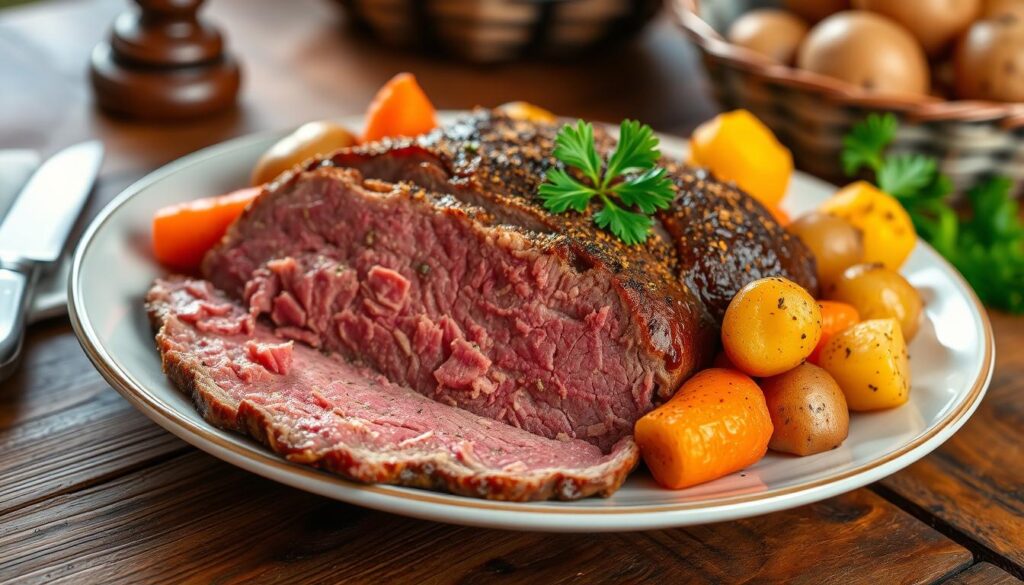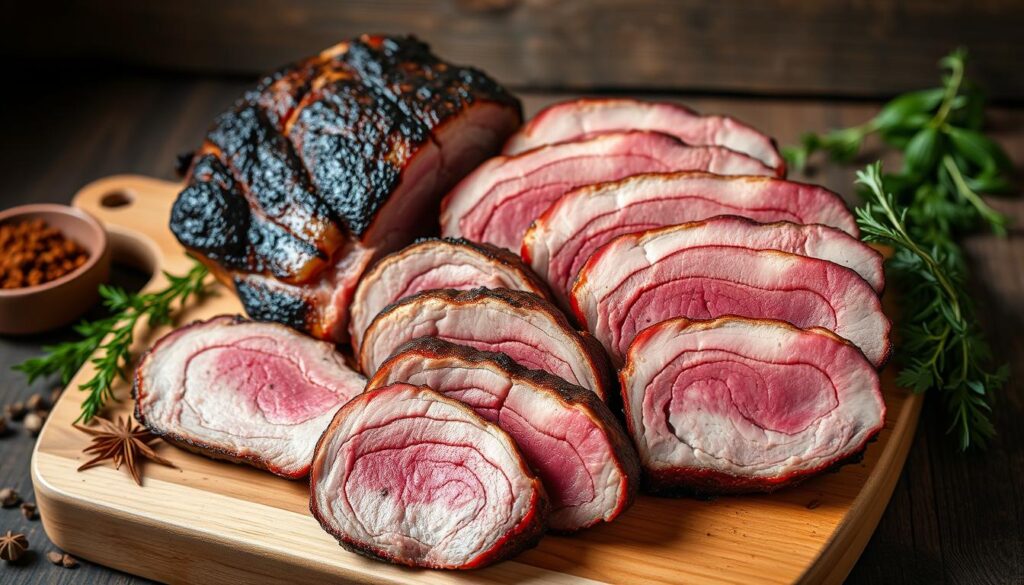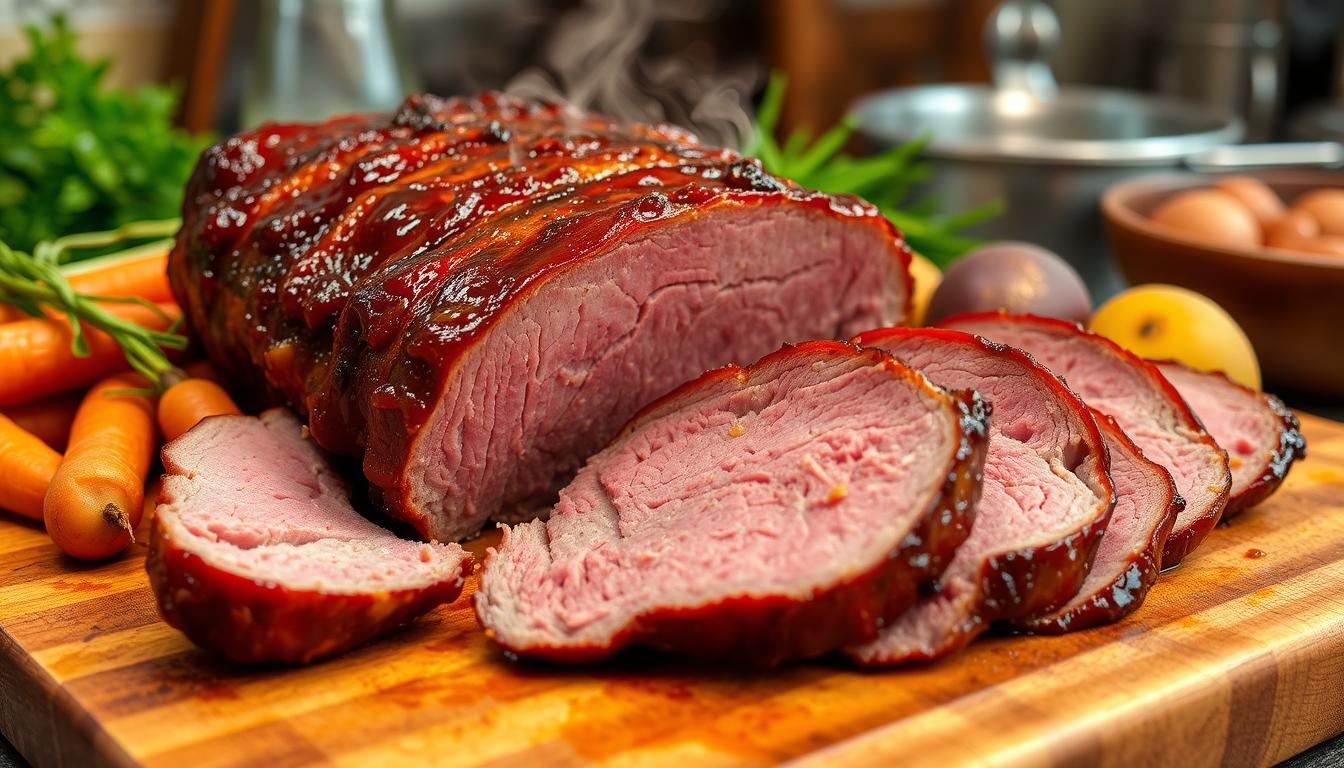Delicious Corned Beef Brisket Recipe: Perfectly Tender
As winter’s chill hits, the smell of slow-cooked corned beef brisket fills the air. It takes you straight to the heart of Irish-American cooking. This dish, with its tender meat and rich sauce, brings back memories of family meals and home.
In this guide, we’ll share the secrets to making the perfect corned beef brisket. It’s a favorite for St. Patrick’s Day but loved all year. Whether you’re an experienced cook or new to the kitchen, you’ll learn how to make a delicious, tender brisket. It will wow your family and friends.
Table of Contents
Key Takeaways
- Discover the origins and cultural significance of corned beef brisket
- Learn how to select the perfect cut of beef for the ultimate tender and flavorful result
- Uncover the essential spices and ingredients needed to create an authentic corned beef brine
- Master the art of brining your brisket for maximum flavor and texture
- Explore the step-by-step process for cooking a mouthwatering corned beef brisket
- Dive into slow cooking techniques for the most tender and succulent corned beef
- Discover creative serving suggestions and pairings to elevate your corned beef experience
Understanding Corned Beef Brisket: History and Tradition
Corned beef brisket is a favorite dish in Irish-American cuisine. It comes from a long history of salt-curing meat. This method was used to keep food fresh when fresh meat was hard to find.
Origins of Salt-Cured Meat
“Corned” describes the large salt grains that are used during the curing process. Brisket, a tough but tasty beef cut, was perfect for this method. The salt made the meat last longer and gave it a unique flavor.
Irish-American Cultural Significance
Corned beef brisket is important in Irish-American culture, especially on St. Patrick’s Day. Irish immigrants in the 19th century used salt-cured meat instead of pork, which was more expensive.
St. Patrick’s Day Connection
The link between corned beef brisket and St. Patrick’s Day is strong in American culture. Its tasty flavors and historical value make it a key part of St. Patrick’s Day celebrations.

“Irish-American cooking has made corned beef brisket a staple due to its flavor and versatility. Its history and cultural significance are a testament to the resilience and adaptability of the Irish people.”
Selecting the Perfect Cut of Beef for Corning
Choosing the right beef cut is key for making great corned beef. Brisket is the top pick, known for its rich flavor and tender texture. It gets even better after curing and cooking. But picking the right brisket can be tricky. Let’s look at what to consider when picking the perfect brisket for your corned beef.
Grades of Beef: Understanding Quality
The beef’s quality greatly affects your corned beef’s taste and texture. Go for USDA Choice or USDA Prime beef for the best flavor and tenderness. Stay away from USDA Select beef, as it might make your corned beef tough and less juicy.
Brisket Anatomy: Selecting the Right Part
There are two components to the brisket: the “flat” and the “point.” The point is fattier and thicker than the flat, which is thinner and more even. The flat is ideal for corned meat that is even and tender. But, the point offers a richer taste and texture.
| Brisket Cut | Characteristics | Recommended Use |
|---|---|---|
| Flat Cut | Lean, uniform thickness | Ideal for classic corned beef dishes |
| Point Cut | Thicker, more marbled | Excellent for braising and shredding |
Choose a brisket with a thick fat cap on top. This fat keeps the meat moist and flavorful during cooking.

With an eye for quality beef and knowledge of brisket anatomy, you’re set to make amazing corned beef. It will amaze your guests and your palate.
Essential Ingredients and Pickling Spices
Making the perfect corned beef brisket begins with the right ingredients and spices. These elements boost the flavor and are vital for curing and tenderizing the meat.
Traditional Spice Blend Components
The spice mix for corning beef includes aromatic and pungent spices. It usually has:
- Whole black peppercorns
- Coriander seeds
- Mustard seeds
- Whole allspice berries
- Bay leaves
- Whole cloves
- Juniper berries
- Caraway seeds
Salt and Curing Ingredients
The curing process for corned beef needs salt and nitrites. These add flavor, preserve the meat, and give it a pink color.
- Kosher salt or sea salt
- Pink curing salt (sodium nitrite)
- Brown sugar or molasses (for sweetness)
Optional Flavoring Additions
You can also add unique flavors to your corned beef brisket. Some favorites include:
- Bay leaves, mustard seeds, coriander seeds, and whole allspice are examples of pickling spices.
- Curing ingredients, like garlic, onions, or ginger
- Spice blend variations, with smoked paprika, fennel seeds, or crushed red pepper flakes
The secret to a great corned beef brisket is the right mix of pickling spices, curing ingredients, and spice blend.
The Art of Brining Your Brisket
Brining is key to making your corned beef brisket tender and flavorful. The meat must be submerged in a saline solution. This lets the flavors soak deep and keeps the meat moist during the curing process.
To start, mix water, salt, and spices in a big container. For every gallon of water, use around half a cup of salt. Stir until the salt dissolves, then add your brisket. Ensure that it is completely submerged in the brine.
- To make the brine solution, put one gallon of water, half a cup of salt, and any additional spices or aromatics you want in a big, non-reactive container.
- Add the beef brisket: Place the brisket into the brine solution, making sure it’s fully submerged.
- Brine for 7-10 days: Keep the container refrigerated and let the brisket cure for 7–10 days, turning the meat periodically to guarantee uniform curing.
- Remove and rinse: After the brining period, remove the brisket from the solution, rinse it thoroughly under cold water, and pat it dry.
The brining time depends on the brisket’s size. But usually, 7-10 days is enough for the curing process. Keep the container in the fridge and flip the meat a few times. This ensures even brining.
Remove the brisket from the brine, give it a thorough rinse, and then pat it dry. Now, your brisket is ready for cooking. It’s time to make it delicious!
Step-by-Step Corned Beef Brisket Recipe
It takes skill to make a corned-beef brisket that is both tender and delicious. To prepare a meal that will impress your loved ones, follow these steps. This guide covers everything from starting to cooking and temperature control, helping you make the perfect brisket.
Preparation Methods
First, rinse the corned beef brisket under cold water to get rid of extra salt. Dry it with paper towels and put it in a big pot or Dutch oven. Make sure the pot has enough water to cover the brisket.
Cooking Techniques
- Start by boiling the water, then lower the heat to simmer. Cover the pot and cook the brisket for 2-3 hours, until it’s tender.
- You can also bake the brisket. Preheat your oven to 325°F (165°C). Put the brisket in a roasting pan with some water, cover it with foil, and bake for 3-4 hours.
- For slow cooking: Place the brisket in a slow cooker to cook it slowly. Cook on low for 8–10 hours or high for 4–6 hours after adding your preferred liquid and covering.
Temperature Guidelines
Check the internal temperature of the corned beef brisket to ensure proper cooking. Use a meat thermometer to aim for 190-195°F (88-91°C). This ensures the brisket is tender, juicy, and full of flavor.
| Cooking Method | Internal Temperature |
|---|---|
| Stovetop Simmering | 190-195°F (88-91°C) |
| Oven Roasting | 190-195°F (88-91°C) |
| Slow Cooker | 190-195°F (88-91°C) |
Remember, patience and detail are key to a great corned beef brisket. Follow these steps, and you’ll get a delicious corned beef recipe that will impress everyone.
Slow Cooking Tips for Maximum Tenderness
Getting the perfect tender and flavorful corned beef brisket is all about slow cooking. This method lets you unlock the meat’s true potential. It turns a tough cut into a delicious treat.
For tender corned beef, cooking time is key. Simmer for two to three hours, or until fork-tender. This time breaks down the meat’s tough parts, making it soft and juicy.
- Slow cooking keeps the beef’s juices in, making it moist and tasty.
- The longer it cooks, the more the spices and seasonings soak into the meat. This adds a rich, complex flavor.
- Be patient – don’t open the lid too often. This can make the meat tough.
To make your corned beef even tender, braise it in a flavorful liquid. Beef broth or broth and beer work well. This adds flavor and tenderizes the meat by breaking down its fibers.
| Cooking Time | Tenderness Level |
|---|---|
| 2-3 hours | Fork-tender |
| 4-5 hours | Extremely tender |
| 6-8 hours | Melt-in-your-mouth |
Remember, slow cooking corned beef requires patience. But the wait is worth it. You’ll get a tender, flavorful dish that will delight your taste buds.
Serving Suggestions and Pairings
There are countless ways to serve your delicious corned beef brisket. Pair it with various side dishes and food pairings for a memorable meal.
Traditional Side Dishes
- Buttery mashed potatoes
- Sautéed cabbage with caraway seeds
- Boiled and buttered carrots
- Creamy colcannon (mashed potatoes with kale or cabbage)
- Steamed or boiled potatoes with parsley butter
Modern Serving Ideas
Don’t just stick to the classics. Get creative with your Irish cuisine pairings. Try serving your corned beef brisket with roasted Brussels sprouts or a zesty slaw. You can also turn leftovers into corned beef hash or Reuben sandwiches.
Wine and Beer Pairings
Choose the perfect drink to go with your corned beef brisket. A robust red wine, such as Merlot or Cabernet Sauvignon, goes nicely with it. For a traditional Irish touch, try a crisp lager or creamy stout.
Whether you serve it in a traditional way or with a modern twist, the goal is to enjoy the Irish cuisine. Ensure that your visitors will want to return for more.
Storage and Leftover Ideas
Storing your corned beef brisket right and finding new ways to use leftovers are key. A few simple tips can help you enjoy this Irish-American dish for days. You’ll love the flavors even after the first meal.
Storing Cooked Corned Beef Brisket
After cooking your corned beef brisket perfectly, it’s crucial to store it well. This keeps it fresh and flavorful. Here’s how to do it right:
- Let the brisket cool down completely before putting it in the fridge.
- Put the brisket in an airtight container or wrap it tightly in plastic or foil.
- The brisket can be stored in the refrigerator for up to four days. If you wish to keep it longer, you can freeze it for up to three months.
- When you reheat it, make sure it gets to 165°F to kill off bacteria.
Delicious Leftover Recipes
Don’t waste those tasty corned beef leftovers! Try these tasty ideas to make your leftover brisket into something new:
- Corned Beef Hash: Cook diced corned beef with potatoes, onions, and spices for a great breakfast or brunch.
- Corned Beef Reuben Sandwich: Stack thinly sliced corned beef, sauerkraut, Swiss cheese, and Thousand Island dressing on rye bread.
- Corned Beef Tacos or Burritos: Shred the corned beef and mix it with your favorite taco or burrito fillings.
- Corned Beef and Cabbage Soup: Chop the corned beef and combine it with vegetables, potatoes, and a flavorful broth.
With these storage tips and leftover recipe ideas, you can enjoy your homemade corned beef brisket for a long time. Savor every last bite of your culinary masterpiece!
Conclusion
Creating homemade corned beef brisket is a rewarding and flavorful journey. This dish has a rich history, tied to Irish-American culture and St. Patrick’s Day celebrations.
With our step-by-step guide and the right ingredients, you can make a tender, flavorful corned beef brisket at home. This homemade version beats store-bought, offering a true taste of corned beef brisket.
Use your homemade corned beef in traditional Irish meals or modern dishes. Its versatility will impress your family and guests. Try new flavors, cooking methods, and serving ideas to make it your own.

